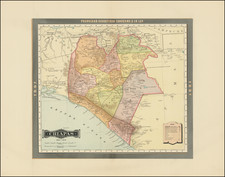Miccaihuitl - the Aztec Festival of the Dead
A beautiful original early 19th-century watercolor of four Aztec deities and festivals, including Miccaihuitl - the pre-Hispanic basis for the Mexican Day of the Dead.
This accomplished watercolor was executed by William H. Shippard, a significant but largely unheralded English mesoamericanist who copied the images from Mexican codices, specifically the Codex Vaticanus A, as it appeared in the color lithograph by Agostino Aglio in Lord Kingsborough's Antiquities of Mexico. Shippard is chiefly remembered today for being a close friend of George Catlin, the famous American painter of North American Indians.
The three figures shown from the Aztec pantheon:
- Veitecuilitl - "The Greater Festival of the Year" - per Shippard's note.
- Miccaihuitl - Festival of the dead held at a transitional time from summer to fall.
- Veymiccailhuitl - "The Greater Festival of the Dead" - per Shippard's note.
- Ochpaniztl - God of Purification, dedicated to Toci (Our Grandmother, a Mexica deity, a wrathful and cruel goddess of war). Also associated with sweeping and the rush of winds that occurred in the valley of Mexico before the winter rains, the end of the growing season and the start of the harvesting season.
William Henry Shippard's Mexican Paintings
William H. Shippard (1803-1865) was a pioneering 19th-century British museologist - an unsung progenitor of modern-day museum anthropology. While he is chiefly remembered as a friend of George Catlin, Shippard's profound interest in the ancient civilizations of Mexico connects him with a cohort of British contemporaries that include Lord Kingsborough and the showman William Bullock. Shippard's fascination with Mesoamerica propelled him to amass a significant collection of visual material derived from Aztec codices which he copied himself. A figure of some intrigue and scholarly ambition, Shippard endeavored to establish the Museum of Mankind in London, which seems to have evolved from his deep interest in early Mexican cultures. Although the museum did not come to fruition, Shippard's original artwork, mainly pen and ink drawings enriched with vibrant hand coloring, based on Mexican codices held in European libraries and collections, remains a valuable historical source, particularly for understanding the allure of Mexican antiquity within early 19th-century British collecting circles.
Capt. William H. Shippard, a friend of George Catlin and an avid watercolorist and museologist, was also a pioneering British Mesoamericanist. Shippard appears in British newspaper notices from the 1840s as a London-based lecturer who spoke about Native Americans and Mexican antiquities. We know he was a friend of George Catlin, and that he was involved in attempts to organize early London museum exhibitions of Mexican antiquities. In the latter efforts Shippard would seem to coincide with a group of like minded prominent English collectors interested in Mexican topics active during the 1820s and 1830s, including Lord Kingsborough and the bibliomaniac Sir Thomas Phillipps, among others. He seems to have been an armchair anthropologist and would-be museum founder, whose ambitious ideas for a London-based museum never got off the ground - at least not beyond the prospectus-printing stage. Certain aspects of Shippard's career are akin to William Bullock, the showman and connoisseur of Mexican antiquities who actually did travel to Mexico. Bullock published a notable book about his Mexican travels, and achieved a level of recognition in his day as the empresario of London's Egyptian Hall, wherein he thrilled large London audiences with his elaborate exhibitions of exotica, including Mexican items.









![[Mexico City and Environs] Mapa de las Lagunas, Rios y Lugares que Circundan a Mexico: para mayor inteligencia de la Historia y Conquista de Mexico que escribió Solis . . . 1783](https://storage.googleapis.com/raremaps/img/small/91029.jpg)
![[ Hernando Cortés ] Map of Tabasco Showing the route followed by Hernando Cortés during 1524-5](https://storage.googleapis.com/raremaps/img/small/100145.jpg)
![(Humboldt Atlas and Text) Geographique et Physique du Royaume de Nouvelle-Espagne [with quarto text:] Essai Politique de la Royaume de la Nouvelle-Espagne](https://storage.googleapis.com/raremaps/img/small/99796.jpg)
![[Chiapas] Carta Postal de la Republica Mexicana Estado de Chiapas . . . 1934](https://storage.googleapis.com/raremaps/img/small/55436.jpg)
![[ Indian Cave and Rock Paintings ] World Primitive Rock Art -- The Conquest of Indian America](https://storage.googleapis.com/raremaps/img/small/93916.jpg)
